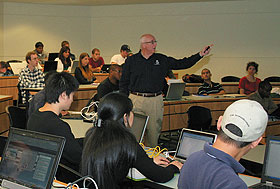  |
| HOME | THIS ISSUE | CALENDAR | GRANTS | BACK ISSUES | < BACK | NEXT > |
Business school transforming engineering students into entrepreneursby Nan Cooper - November 17, 2008 |
||||
| Marcian Hoff invented the microprocessor; Stephen Wozniak co-founded Apple Computer; Karlheinz Brandenburg co-developed the MP3 compression scheme. All are engineers. Yet starting a new business is a risky path for an innovator. In order to provide undergraduate engineering majors with business tools that will help them become successful entrepreneurs, this fall, the schools of Engineering and Business embarked on a new joint venture. Ten seniors and 15 juniors majoring in engineering opted to augment their coursework with rigorous MBA-level entrepreneurship classes offered through the School of Business, and to apply their new business know-how to their senior design projects. Blending different approaches The future MBAs, also, through their exposure to engineers, will better understand and appreciate the analytical framework that engineers employ in conceiving new ideas, solving technical challenges, and improving upon existing products. The two MBA-level management courses, both taught by Dino, are Opportunity Generation, Assessment, & Promotion, and Venture Planning, Management, & Growth. The first leads students through key facets of the entrepreneurial process and helps them create, identify, evaluate, and shape new business opportunities. The second involves a complex business simulation conducted in the context of a competitive high technology marketplace, and the development of a business plan undergirded by engineering technology. In both classes, Dino introduces and emphasizes the concept of lateral thinking. His courses are designed to mirror the often intense business environment in which employees may be called upon to present and defend a plan with little or no advance notice. Engineering students must quickly assimilate business fundamentals, and also master the art of moving decision-makers to action. Jonathan Riscica, a biomedical engineering senior, decided to participate in the program after completing a summer internship that excited him. “It’s been a great experience so far,” he says, adding that “the business side of things is much broader in perspective, and less concrete than the more methodical, structured engineering approach.” In one assignment for the Opportunity Generation class, the team was given one week to conceive a business and generate actual funds to be donated to charity.
Riscica’s team hatched several schemes that yielded real cash for charity: they sold donated coffee and donuts in the Student Union and patriotic ribbons at a football game, and auctioned lunch with University President Michael Hogan to the highest bidder. John Bennett, associate dean for academic affairs in the School of Engineering, oversees the engineering side of the program. During this first year, seniors planning an entrepreneurship senior design project are taking the two management courses simultaneously during the fall semester, along with their regular engineering courses; participating juniors will complete the two courses over two years. Bennett says the entrepreneurship senior design project students will apply the know-how from their MBA courses to their senior design projects. Team interactions Forse is enthusiastic about the MBA coursework and team collaborations. He observes that the MBA students are more apt to arrive at decisions quickly, while engineers are trained to develop decisions after methodical analysis; the two contingents are beginning to adapt their approaches based on the team interactions. He and his teammates have already taken some initial steps on their UConn Health Center-sponsored senior design project, which involves design and development of a multi-terrain wheelchair featuring strictly mechanical operation. Allison Ray and Philip McDonald, two second-year MBA candidates, say they were initially surprised to learn that undergraduate engineering students would be participating in their entrepreneurship course. McDonald notes that many MBA students are a decade older than their engineering teammates and separated by dissimilar academic training and a different academic culture. The differences quickly dissolved, however, as the teams learned to meld their skills. Ray and McDonald say that as a result of their interactions with engineering teammates, they are learning to approach business problems from a more technical perspective, while the engineering students are gaining insight into business fundamentals such as nuances of balance sheets, profit and loss calculations, and marketing models. |
| ADVANCE HOME UCONN HOME |

